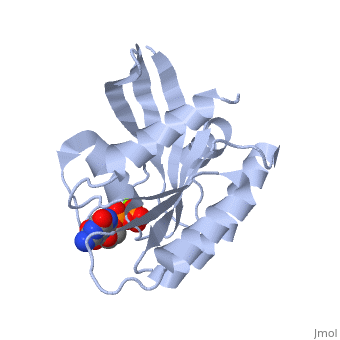2quz
From Proteopedia
Crystal Structure of the activating H-RasK117R mutant in Costello Syndrome, bound to Mg-GDP
Structural highlights
DiseaseRASH_HUMAN Defects in HRAS are the cause of faciocutaneoskeletal syndrome (FCSS) [MIM:218040. A rare condition characterized by prenatally increased growth, postnatal growth deficiency, mental retardation, distinctive facial appearance, cardiovascular abnormalities (typically pulmonic stenosis, hypertrophic cardiomyopathy and/or atrial tachycardia), tumor predisposition, skin and musculoskeletal abnormalities.[1] [2] [3] [4] [5] [6] [7] Defects in HRAS are the cause of congenital myopathy with excess of muscle spindles (CMEMS) [MIM:218040. CMEMS is a variant of Costello syndrome.[8] Defects in HRAS may be a cause of susceptibility to Hurthle cell thyroid carcinoma (HCTC) [MIM:607464. Hurthle cell thyroid carcinoma accounts for approximately 3% of all thyroid cancers. Although they are classified as variants of follicular neoplasms, they are more often multifocal and somewhat more aggressive and are less likely to take up iodine than are other follicular neoplasms. Note=Mutations which change positions 12, 13 or 61 activate the potential of HRAS to transform cultured cells and are implicated in a variety of human tumors. Defects in HRAS are a cause of susceptibility to bladder cancer (BLC) [MIM:109800. A malignancy originating in tissues of the urinary bladder. It often presents with multiple tumors appearing at different times and at different sites in the bladder. Most bladder cancers are transitional cell carcinomas. They begin in cells that normally make up the inner lining of the bladder. Other types of bladder cancer include squamous cell carcinoma (cancer that begins in thin, flat cells) and adenocarcinoma (cancer that begins in cells that make and release mucus and other fluids). Bladder cancer is a complex disorder with both genetic and environmental influences. Note=Defects in HRAS are the cause of oral squamous cell carcinoma (OSCC).[9] Defects in HRAS are the cause of Schimmelpenning-Feuerstein-Mims syndrome (SFM) [MIM:163200. A disease characterized by sebaceous nevi, often on the face, associated with variable ipsilateral abnormalities of the central nervous system, ocular anomalies, and skeletal defects. Many oral manifestations have been reported, not only including hypoplastic and malformed teeth, and mucosal papillomatosis, but also ankyloglossia, hemihyperplastic tongue, intraoral nevus, giant cell granuloma, ameloblastoma, bone cysts, follicular cysts, oligodontia, and odontodysplasia. Sebaceous nevi follow the lines of Blaschko and these can continue as linear intraoral lesions, as in mucosal papillomatosis.[10] FunctionRASH_HUMAN Ras proteins bind GDP/GTP and possess intrinsic GTPase activity.[11] [12] [13] Evolutionary ConservationCheck, as determined by ConSurfDB. You may read the explanation of the method and the full data available from ConSurf. Publication Abstract from PubMedCostello syndrome is a mental retardation syndrome characterized by high birth weight, postnatal growth retardation, coarse face, loose skin, cardiovascular problems, and tumor predisposition. De novo heterozygous missense mutations in HRAS codon 12 and 13 disturbing the intrinsic GTP hydrolysis cause Costello syndrome. We report a patient with typical Costello syndrome and a novel heterozygous missense mutation in codon 117 (c.350A>G, p.Lys117Arg) of the HRAS gene, resulting in constitutive activation of the RAS/MAPK pathway similar to the typical p.Gly12Ser and p.Gly12Ala mutations. Recombinant HRAS p.Lys117Arg demonstrates normal intrinsic GTP hydrolysis and responsiveness to GTPase-activating proteins, but the nucleotide dissociation rate is increased 80-fold. Consistent with the biochemical data, the crystal structure of the p.Lys117Arg mutant indicates an altered interaction pattern of the side chain that is associated with unfavorable nucleotide binding properties. Together, these data show that a RAS mutation that only perturbs guanine nucleotide binding has similar functional consequences as mutations that impair GTP hydrolysis and causes human disease. Mutation analysis in Costello syndrome: functional and structural characterization of the HRAS p.Lys117Arg mutation.,Denayer E, Parret A, Chmara M, Schubbert S, Vogels A, Devriendt K, Frijns JP, Rybin V, de Ravel TJ, Shannon K, Cools J, Scheffzek K, Legius E Hum Mutat. 2008 Feb;29(2):232-9. PMID:17979197[14] From MEDLINE®/PubMed®, a database of the U.S. National Library of Medicine. See AlsoReferences
| ||||||||||||||||||||


